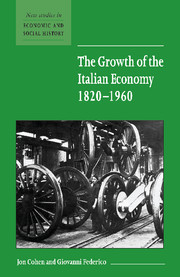Book contents
- Frontmatter
- Contents
- List of figures
- List of tables
- Acknowledgements
- 1 Introduction
- 2 Measuring change in the long run: the data
- 3 The big picture: models of growth and structural change
- 4 Modernization versus tradition: new views and old on agriculture
- 5 Against all odds? The growth of industry and services
- 6 Macroeconomic policy, institutions, and the balance of payments
- 7 An economic miracle? Italy in the Golden Age, 1945–1960
- 8 Conclusion
- Bibliography
- Index
- New Studies in Economic and Social History
- Previously published as Studies in Economic and Social History
- Economic History Society
3 - The big picture: models of growth and structural change
Published online by Cambridge University Press: 05 June 2012
- Frontmatter
- Contents
- List of figures
- List of tables
- Acknowledgements
- 1 Introduction
- 2 Measuring change in the long run: the data
- 3 The big picture: models of growth and structural change
- 4 Modernization versus tradition: new views and old on agriculture
- 5 Against all odds? The growth of industry and services
- 6 Macroeconomic policy, institutions, and the balance of payments
- 7 An economic miracle? Italy in the Golden Age, 1945–1960
- 8 Conclusion
- Bibliography
- Index
- New Studies in Economic and Social History
- Previously published as Studies in Economic and Social History
- Economic History Society
Summary
3.1 Between roughly 1860 and 1940 Italy went from being a poor, backward, primarily agricultural country to a relatively prosperous, modern industrial economy. There were still pockets of poverty and backwardness, especially in the South, and agriculture was still the dominant economic activity, but the country also possessed a large, modern and competitive industrial sector. By 1951, the date of the first post-WWII census, agriculture employed less than 50 per cent of the active population for the first time in the country's ninety-year history (cf. table 2.3). The purpose of the macroeconomic models of growth and fluctuations is, in general, to help us understand the nature and timing of this transformation.
Two views of Italian economic development dominate the literature. In one, it is seen as a success, even though modest; in the other, as a failure, even though partial – the two positions are the scholarly equivalent of the optimist's half-full and the pessimist's half-empty glass of water. Adherents to the former view once again fall into two groups. Those in the first argue that in the 1880s (Romeo 1961, 1963) or 1890s (Gerschenkron 1968) Italy underwent a discontinuous jump in industrial production that marked the beginning of its modern economic growth. Their objective is to pinpoint the spurt and to explain why it occurred when and where it did.
Those in the second maintain, instead, that the observed surge in the growth rate was merely a positive cyclical fluctuation around a rising trend.
- Type
- Chapter
- Information
- The Growth of the Italian Economy, 1820–1960 , pp. 17 - 29Publisher: Cambridge University PressPrint publication year: 2001



